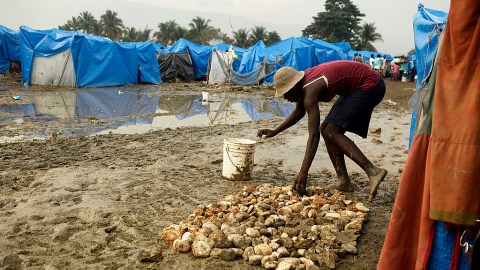Is Donor-Driven Funding Haiti’s Solution?

In January of 2010, the ground in Haiti rumbled with the force of a 7.0 magnitude earthquake. The earthquake caused horrific devastation, leveling homes and destroying local economies. Foreign countries and NGO’s responded with massive investments of aid. But an article published by TIME magazine last year shows that the capital city of Port-au-Prince is unfortunately still struggling after five years of recovery.
Right now, more than 60,000 people still live in camps for Internally Displaced Persons (IDPs), mostly within the vicinity of Port-au-Prince. While some people might be managing to eke out a living within the camps, it’s a poor situation for public health. Cholera has proliferated in Haiti since the earthquake happened, due to bad sanitation conditions (the disease is waterborne). While the initial outbreak might have been contained under different circumstances, the ongoing IDP crisis means that cholera has established a strong foothold. New research suggests that the disease may now have become endemic to the country. So it seems that there is still a long ways to go before Haiti is stable and thriving.
This is the scene that startup nonprofit New Story entered into when it decided to take a radical approach toward getting IDP Haitians rehoused. In a traditional nonprofit model, donors often give money and the organization they give to decides how to best allocate those funds. New Story is instead showing their donors exactly what the need is and just where their dollars go. All of an individual’s donations go toward building a house for a family of their choosing, and the donor can later watch a video of their family moving into the new home. Using this model, New Story housed 1,200 people in just under a year, a result that some argue bigger organizations haven’t been able to achieve.
When a place like Haiti has seen so much destruction and despair it’s easy to look to a shiny, promising new approach as the ultimate solution. But one successful trial might not necessarily mean that we have the answer. It’ll be important to see if the housing works out for former-IDPs in the long run and if donors will continue to fund the approach once it too becomes an old method. Additionally, it raises questions about who gets to make decisions. Should donors be allowed only to fund the families they like the best or see as the most needy? What about someone who doesn’t seem so compelling on video and still needs a home just as badly?
While there are questions, New Story’s approach is certainly getting many people housed, and that deserves an applause. Time will tell how many people it can work for and how the organization’s efforts fit into the broader vision for Haiti’s reconstruction and resettlement.
—
Image: Chip Somodevilla / Staff via Getty Images





